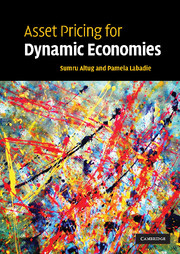Book contents
- Frontmatter
- Contents
- List of figures
- List of tables
- Preface
- I BASIC CONCEPTS
- 1 Complete contingent claims
- 2 Arbitrage and asset valuation
- 3 Expected utility
- 4 CAPM and APT
- 5 Consumption and saving
- II RECURSIVE MODELS
- III MONETARY AND INTERNATIONAL MODELS
- IV MODELS WITH MARKET INCOMPLETENESS
- V SUPPLEMENTARY MATERIAL
- Bibliography
- Index
4 - CAPM and APT
Published online by Cambridge University Press: 01 June 2010
- Frontmatter
- Contents
- List of figures
- List of tables
- Preface
- I BASIC CONCEPTS
- 1 Complete contingent claims
- 2 Arbitrage and asset valuation
- 3 Expected utility
- 4 CAPM and APT
- 5 Consumption and saving
- II RECURSIVE MODELS
- III MONETARY AND INTERNATIONAL MODELS
- IV MODELS WITH MARKET INCOMPLETENESS
- V SUPPLEMENTARY MATERIAL
- Bibliography
- Index
Summary
In Chapters 1 and 2, we introduced the general equilibrium approach to asset pricing, and presented a rationalization of the implied asset-pricing relations based on much weaker notions of the absence of arbitrage. Whereas these theoretical approaches provide intellectually appealing and elegant characterizations of asset pricing, the empirical finance literature has been dominated by two other approaches. These are the capital asset-pricing model (CAPM) of Sharpe [389], Lintner [311], and others, and the arbitrage pricing theory (APT) proposed by Ross [369]. The former approach exploits a risk-return relationship for the pricing of assets whereas the latter imposes a factor structure. These approaches also have implications for the theory of portfolio choice.
As is well known, the CAPM prices the riskiness of an individual asset in terms of its covariance with the market portfolio. By contrast, the APT prices assets in terms of an underlying set of risk factors. The CAPM typically exploits the implications of expected utility maximization with respect to end-of-period wealth whereas the APT has been derived based on absence of arbitrage arguments. We describe the alternative sets of assumptions under which these approaches can be derived, and compare their implications with the general equilibrium approach to asset pricing.
THE CAPITAL ASSET – PRICING MODEL
The CAPM has gained widespread use because it provides restrictions for investors' portfolios and asset prices and returns that appear to be validated by data on a variety of securities. The CAPM formulation can be derived in different ways.
Information
- Type
- Chapter
- Information
- Asset Pricing for Dynamic Economies , pp. 72 - 85Publisher: Cambridge University PressPrint publication year: 2008
